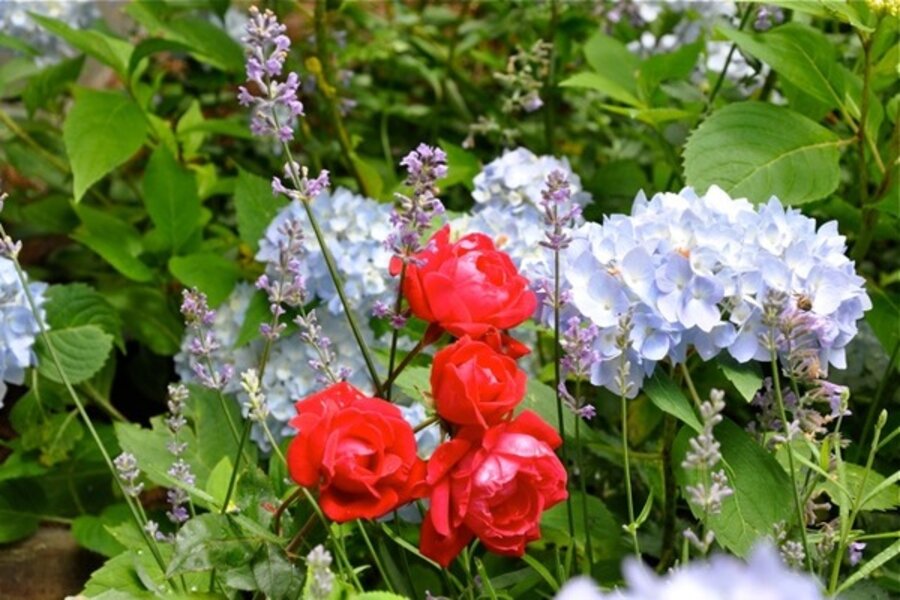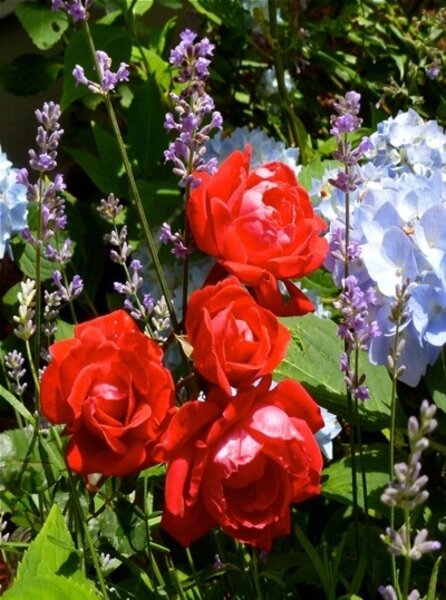Lavender is a fragrant addition to summer gardens
Loading...
Rosemary may be known as the herb of remembrance, but it is the unmistakable perfume of lavender that transports me to days gone by: A stroll through an English garden, an after shave my dad once wore, a sleep pillow handcrafted by a neighbor.
The evocative fragrance alone makes it worth growing, but lavenders are also wonderful companion plants. They’re perfect choices for edging and low hedges, and create colorful accents in the garden as well as in containers.
And, of course, they make a powerfully fragrant combo when planted alongside roses.
Lavender's long history
Lavender is native to the Mediterranean region and has been used to perfume, cleanse, and heal for 2,500 years. Ancient Egyptians wrapped their dead in shrouds dipped in lavender.
The Greeks employed it to deter all manner of ills from insomnia to insanity. Its fresh scent made it a favorite with the Romans who used the herb extensively in bath water.
Lavender has been a part of the medicinal garden as far back as 77 AD. During the Middle Ages, Benedictine monks cultivated the plant for a variety of uses, including banishing head lice.
Fictional monk detective Brother Cadfael grew lavender in his walled herb garden. He noted that it was “helpful for all disorders that trouble the head and spirit, and its scent is calming.”
The Elizabethans scattered lavender on the floors to perfume the house, deter insects in the linen closet and mask displeasing odors. It was also sold on the streets of London by vendors who claimed branches of lavender fastened to each wrist could ward off the bubonic plague.
About the same time, lavenders were used in elaborate knot gardens designed to resemble intricate embroidery designs of the day.
Colonists brought lavenders from England to America, where today they are prized more as a garden ornamental than for any medicinal uses.
The right lavender for the right zone
A number of species are cultivated throughout the world but our best performers are English, Spanish, French, and the lavandins (a class of lavender hybrids). However, not all will succeed everywhere in the country.
Munstead, Hidcote, and Croxton’s Wild (which is hardy to Zone 4b) are the best varieties of lavender for overwintering in most of temperate America.
While English lavender (L. angustifolia) is winter-hardy to Zone 5 and comfortable in hot, arid areas of the West, it generally will not tolerate the steaming summers of the Deep South.
French and Spanish varieties don’t mind the humidity, but may need to be treated as annuals north of Zone 9. Provence and Sweet are two varieties that have done consistently well in Southern gardens.
No matter where you live, all lavenders require full sun, an airy location, and slightly alkaline soil. Superior drainage is a must; otherwise dreaded root rot may come to call. Adding rotted manure and small stones to both clay and sandy soils will help improve drainage problems.
Lavenders may require a little extra water during their first season, but they don’t need fertilizer. Some experts also recommend sprinkling a bit of potash around the base of each bush in the spring to heighten flower quality and color.
Lavender care
Spring is also the time to carry out your pruning chores – cut back hard to about eight inches high. Otherwise your plants will get lanky and woody. Then tidy up unruly branches over the growing season. Be sure to stop pruning by the first of October to give plants a chance to harden off before winter.
Harvest flower stems just as they begin to open. Pick the dark-flowered lavenders when just one or two flowers are open. Choose a warm, dry day and prune late in the morning – damp flower stalks can encourage mold. Hang small bunches of cuttings tied with rubber bands upside down to dry in a well-ventilated room. Don’t allow sunlight to hit your bundles or flowers might fade.
Once the heads have dried, there are all sorts of ways to enjoy the harvest: Add a pinch of lavender flowers to freshly baked breads. Mix the flowers in potpourris or create your own unique sachets. Then breathe deeply and recapture some cherished summer memories.
PSSSST: Recently I wrote about trying to replace some of my favorite plants after moving. I’ve since discovered a wonderful small nursery that specializes in antique and old garden roses. If you are looking for something special or hard-to-find, check out Rose Petals Nursery.
Editor's Note: For more about cooking with lavender and growing Spanish lavender in Zone 8, see Growing and cooking with lavender and rice, a Diggin' It blog post from earlier this week..
-----
Lynn Hunt, the Rose Whisperer, is one of more than a dozen expert gardeners who blog regularly at Diggin' It. She's an accredited horticultural judge and a Consulting Rosarian Emeritus for the American Rose Society. She has won dozens of awards for her writing in newspapers, magazines, and television. After a recent move, she grows roses and other plants in her garden in the mountains of western North Carolina.. To read more by Lynn, click here.You can also follow her on Twitter and read her Dirt Diaries.






